BBA220 - New Venture: Power Brick Financial Analysis & Projections
VerifiedAdded on 2023/06/03
|8
|1482
|321
Report
AI Summary
This report presents a comprehensive financial analysis of the 'Power Brick' product within the context of new venture management. It includes a detailed break-even analysis, calculating the units required to be sold (4,375) and the corresponding dollar sales ($148,750) to achieve profitability, considering fixed costs ($122,500) and variable costs ($6 per unit). Furthermore, the report features pro forma financial projections, encompassing income statements, balance sheets, and cash flow statements for the first three years of operation, offering insights into the venture's potential financial performance. Key financial ratios are also analyzed, providing a holistic view of the business's financial health and viability. This document is available on Desklib, where students can find more solved assignments and past papers.
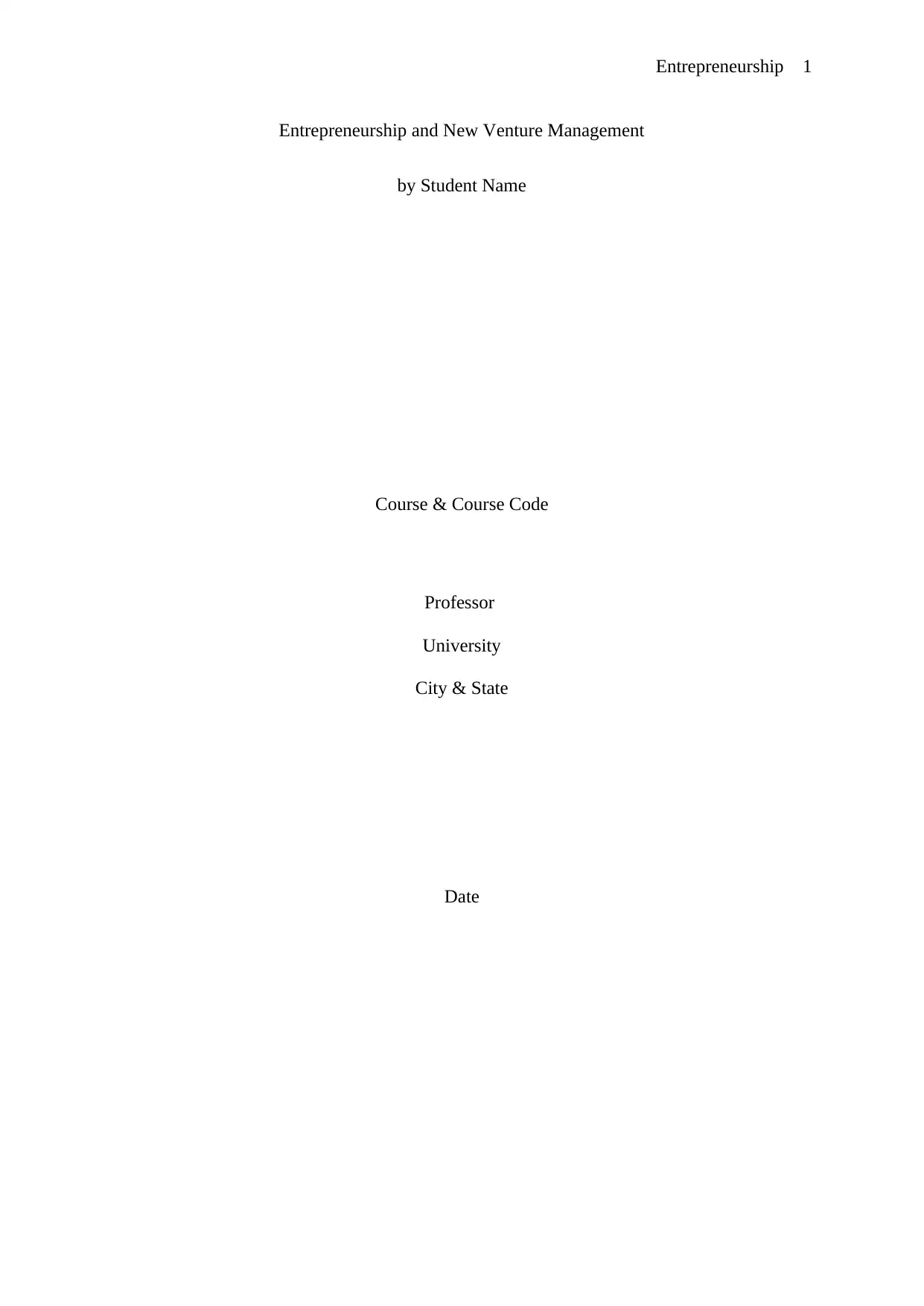
Entrepreneurship 1
Entrepreneurship and New Venture Management
by Student Name
Course & Course Code
Professor
University
City & State
Date
Entrepreneurship and New Venture Management
by Student Name
Course & Course Code
Professor
University
City & State
Date
Paraphrase This Document
Need a fresh take? Get an instant paraphrase of this document with our AI Paraphraser
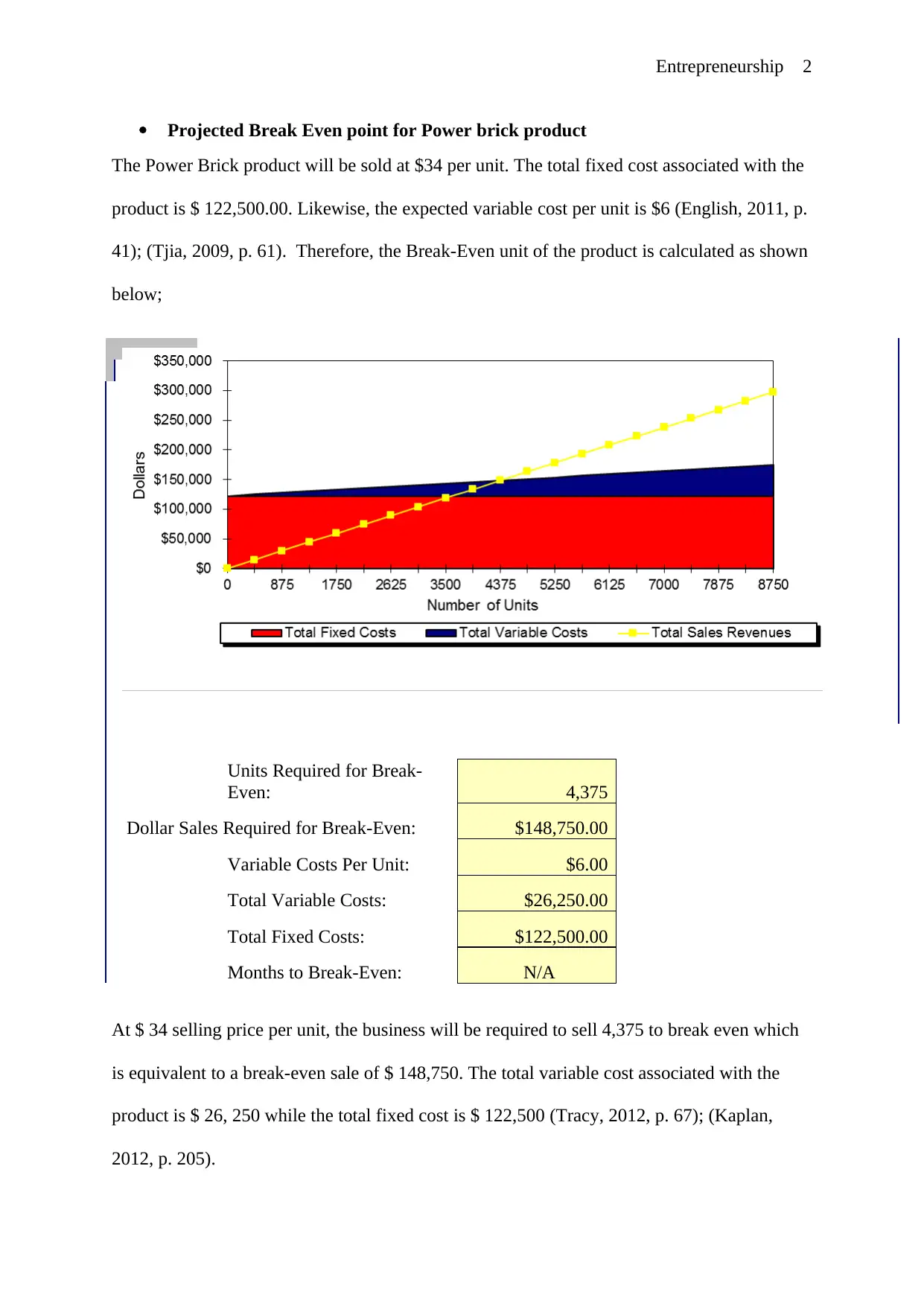
Entrepreneurship 2
Projected Break Even point for Power brick product
The Power Brick product will be sold at $34 per unit. The total fixed cost associated with the
product is $ 122,500.00. Likewise, the expected variable cost per unit is $6 (English, 2011, p.
41); (Tjia, 2009, p. 61). Therefore, the Break-Even unit of the product is calculated as shown
below;
Units Required for Break-
Even: 4,375
Dollar Sales Required for Break-Even: $148,750.00
Variable Costs Per Unit: $6.00
Total Variable Costs: $26,250.00
Total Fixed Costs: $122,500.00
Months to Break-Even: N/A
At $ 34 selling price per unit, the business will be required to sell 4,375 to break even which
is equivalent to a break-even sale of $ 148,750. The total variable cost associated with the
product is $ 26, 250 while the total fixed cost is $ 122,500 (Tracy, 2012, p. 67); (Kaplan,
2012, p. 205).
Projected Break Even point for Power brick product
The Power Brick product will be sold at $34 per unit. The total fixed cost associated with the
product is $ 122,500.00. Likewise, the expected variable cost per unit is $6 (English, 2011, p.
41); (Tjia, 2009, p. 61). Therefore, the Break-Even unit of the product is calculated as shown
below;
Units Required for Break-
Even: 4,375
Dollar Sales Required for Break-Even: $148,750.00
Variable Costs Per Unit: $6.00
Total Variable Costs: $26,250.00
Total Fixed Costs: $122,500.00
Months to Break-Even: N/A
At $ 34 selling price per unit, the business will be required to sell 4,375 to break even which
is equivalent to a break-even sale of $ 148,750. The total variable cost associated with the
product is $ 26, 250 while the total fixed cost is $ 122,500 (Tracy, 2012, p. 67); (Kaplan,
2012, p. 205).
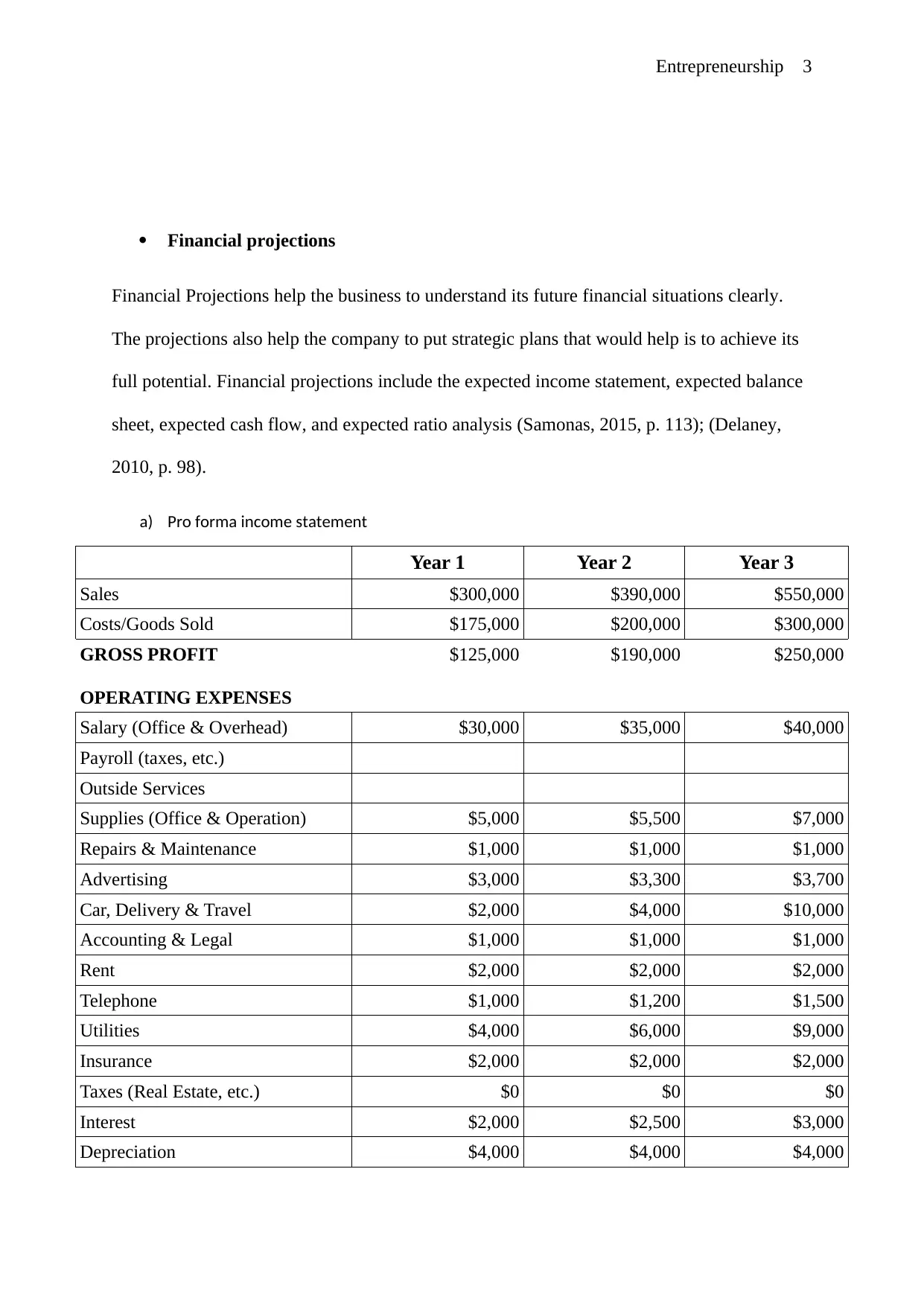
Entrepreneurship 3
Financial projections
Financial Projections help the business to understand its future financial situations clearly.
The projections also help the company to put strategic plans that would help is to achieve its
full potential. Financial projections include the expected income statement, expected balance
sheet, expected cash flow, and expected ratio analysis (Samonas, 2015, p. 113); (Delaney,
2010, p. 98).
a) Pro forma income statement
Year 1 Year 2 Year 3
Sales $300,000 $390,000 $550,000
Costs/Goods Sold $175,000 $200,000 $300,000
GROSS PROFIT
OPERATING EXPENSES
$125,000 $190,000 $250,000
Salary (Office & Overhead) $30,000 $35,000 $40,000
Payroll (taxes, etc.)
Outside Services
Supplies (Office & Operation) $5,000 $5,500 $7,000
Repairs & Maintenance $1,000 $1,000 $1,000
Advertising $3,000 $3,300 $3,700
Car, Delivery & Travel $2,000 $4,000 $10,000
Accounting & Legal $1,000 $1,000 $1,000
Rent $2,000 $2,000 $2,000
Telephone $1,000 $1,200 $1,500
Utilities $4,000 $6,000 $9,000
Insurance $2,000 $2,000 $2,000
Taxes (Real Estate, etc.) $0 $0 $0
Interest $2,000 $2,500 $3,000
Depreciation $4,000 $4,000 $4,000
Financial projections
Financial Projections help the business to understand its future financial situations clearly.
The projections also help the company to put strategic plans that would help is to achieve its
full potential. Financial projections include the expected income statement, expected balance
sheet, expected cash flow, and expected ratio analysis (Samonas, 2015, p. 113); (Delaney,
2010, p. 98).
a) Pro forma income statement
Year 1 Year 2 Year 3
Sales $300,000 $390,000 $550,000
Costs/Goods Sold $175,000 $200,000 $300,000
GROSS PROFIT
OPERATING EXPENSES
$125,000 $190,000 $250,000
Salary (Office & Overhead) $30,000 $35,000 $40,000
Payroll (taxes, etc.)
Outside Services
Supplies (Office & Operation) $5,000 $5,500 $7,000
Repairs & Maintenance $1,000 $1,000 $1,000
Advertising $3,000 $3,300 $3,700
Car, Delivery & Travel $2,000 $4,000 $10,000
Accounting & Legal $1,000 $1,000 $1,000
Rent $2,000 $2,000 $2,000
Telephone $1,000 $1,200 $1,500
Utilities $4,000 $6,000 $9,000
Insurance $2,000 $2,000 $2,000
Taxes (Real Estate, etc.) $0 $0 $0
Interest $2,000 $2,500 $3,000
Depreciation $4,000 $4,000 $4,000
⊘ This is a preview!⊘
Do you want full access?
Subscribe today to unlock all pages.

Trusted by 1+ million students worldwide
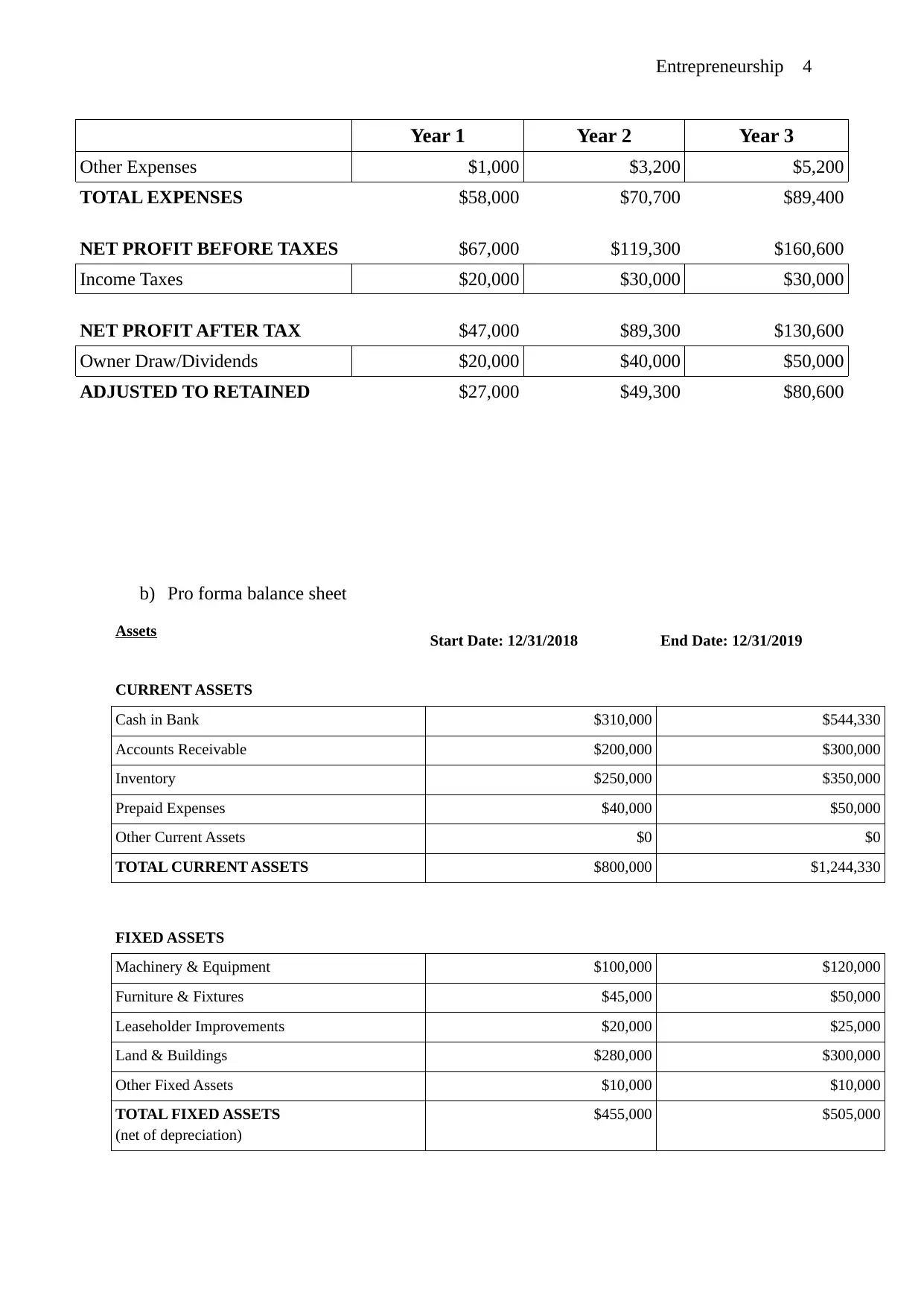
Entrepreneurship 4
Year 1 Year 2 Year 3
Other Expenses $1,000 $3,200 $5,200
TOTAL EXPENSES $58,000 $70,700 $89,400
NET PROFIT BEFORE TAXES $67,000 $119,300 $160,600
Income Taxes $20,000 $30,000 $30,000
NET PROFIT AFTER TAX $47,000 $89,300 $130,600
Owner Draw/Dividends $20,000 $40,000 $50,000
ADJUSTED TO RETAINED $27,000 $49,300 $80,600
b) Pro forma balance sheet
Assets Start Date: 12/31/2018 End Date: 12/31/2019
CURRENT ASSETS
Cash in Bank $310,000 $544,330
Accounts Receivable $200,000 $300,000
Inventory $250,000 $350,000
Prepaid Expenses $40,000 $50,000
Other Current Assets $0 $0
TOTAL CURRENT ASSETS $800,000 $1,244,330
FIXED ASSETS
Machinery & Equipment $100,000 $120,000
Furniture & Fixtures $45,000 $50,000
Leaseholder Improvements $20,000 $25,000
Land & Buildings $280,000 $300,000
Other Fixed Assets $10,000 $10,000
TOTAL FIXED ASSETS
(net of depreciation)
$455,000 $505,000
Year 1 Year 2 Year 3
Other Expenses $1,000 $3,200 $5,200
TOTAL EXPENSES $58,000 $70,700 $89,400
NET PROFIT BEFORE TAXES $67,000 $119,300 $160,600
Income Taxes $20,000 $30,000 $30,000
NET PROFIT AFTER TAX $47,000 $89,300 $130,600
Owner Draw/Dividends $20,000 $40,000 $50,000
ADJUSTED TO RETAINED $27,000 $49,300 $80,600
b) Pro forma balance sheet
Assets Start Date: 12/31/2018 End Date: 12/31/2019
CURRENT ASSETS
Cash in Bank $310,000 $544,330
Accounts Receivable $200,000 $300,000
Inventory $250,000 $350,000
Prepaid Expenses $40,000 $50,000
Other Current Assets $0 $0
TOTAL CURRENT ASSETS $800,000 $1,244,330
FIXED ASSETS
Machinery & Equipment $100,000 $120,000
Furniture & Fixtures $45,000 $50,000
Leaseholder Improvements $20,000 $25,000
Land & Buildings $280,000 $300,000
Other Fixed Assets $10,000 $10,000
TOTAL FIXED ASSETS
(net of depreciation)
$455,000 $505,000
Paraphrase This Document
Need a fresh take? Get an instant paraphrase of this document with our AI Paraphraser
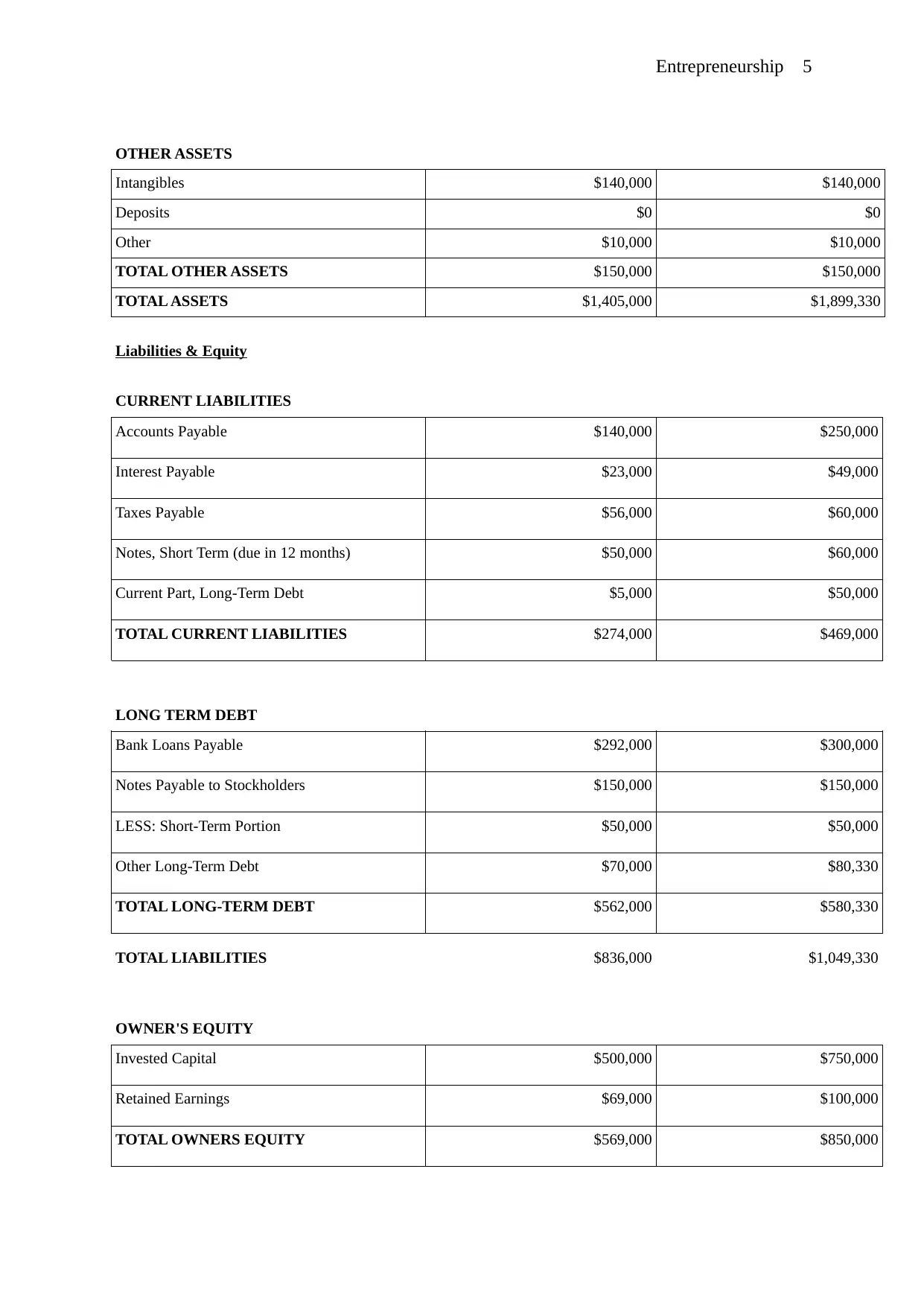
Entrepreneurship 5
OTHER ASSETS
Intangibles $140,000 $140,000
Deposits $0 $0
Other $10,000 $10,000
TOTAL OTHER ASSETS $150,000 $150,000
TOTAL ASSETS $1,405,000 $1,899,330
Liabilities & Equity
CURRENT LIABILITIES
Accounts Payable $140,000 $250,000
Interest Payable $23,000 $49,000
Taxes Payable $56,000 $60,000
Notes, Short Term (due in 12 months) $50,000 $60,000
Current Part, Long-Term Debt $5,000 $50,000
TOTAL CURRENT LIABILITIES $274,000 $469,000
LONG TERM DEBT
Bank Loans Payable $292,000 $300,000
Notes Payable to Stockholders $150,000 $150,000
LESS: Short-Term Portion $50,000 $50,000
Other Long-Term Debt $70,000 $80,330
TOTAL LONG-TERM DEBT $562,000 $580,330
TOTAL LIABILITIES $836,000 $1,049,330
OWNER'S EQUITY
Invested Capital $500,000 $750,000
Retained Earnings $69,000 $100,000
TOTAL OWNERS EQUITY $569,000 $850,000
OTHER ASSETS
Intangibles $140,000 $140,000
Deposits $0 $0
Other $10,000 $10,000
TOTAL OTHER ASSETS $150,000 $150,000
TOTAL ASSETS $1,405,000 $1,899,330
Liabilities & Equity
CURRENT LIABILITIES
Accounts Payable $140,000 $250,000
Interest Payable $23,000 $49,000
Taxes Payable $56,000 $60,000
Notes, Short Term (due in 12 months) $50,000 $60,000
Current Part, Long-Term Debt $5,000 $50,000
TOTAL CURRENT LIABILITIES $274,000 $469,000
LONG TERM DEBT
Bank Loans Payable $292,000 $300,000
Notes Payable to Stockholders $150,000 $150,000
LESS: Short-Term Portion $50,000 $50,000
Other Long-Term Debt $70,000 $80,330
TOTAL LONG-TERM DEBT $562,000 $580,330
TOTAL LIABILITIES $836,000 $1,049,330
OWNER'S EQUITY
Invested Capital $500,000 $750,000
Retained Earnings $69,000 $100,000
TOTAL OWNERS EQUITY $569,000 $850,000
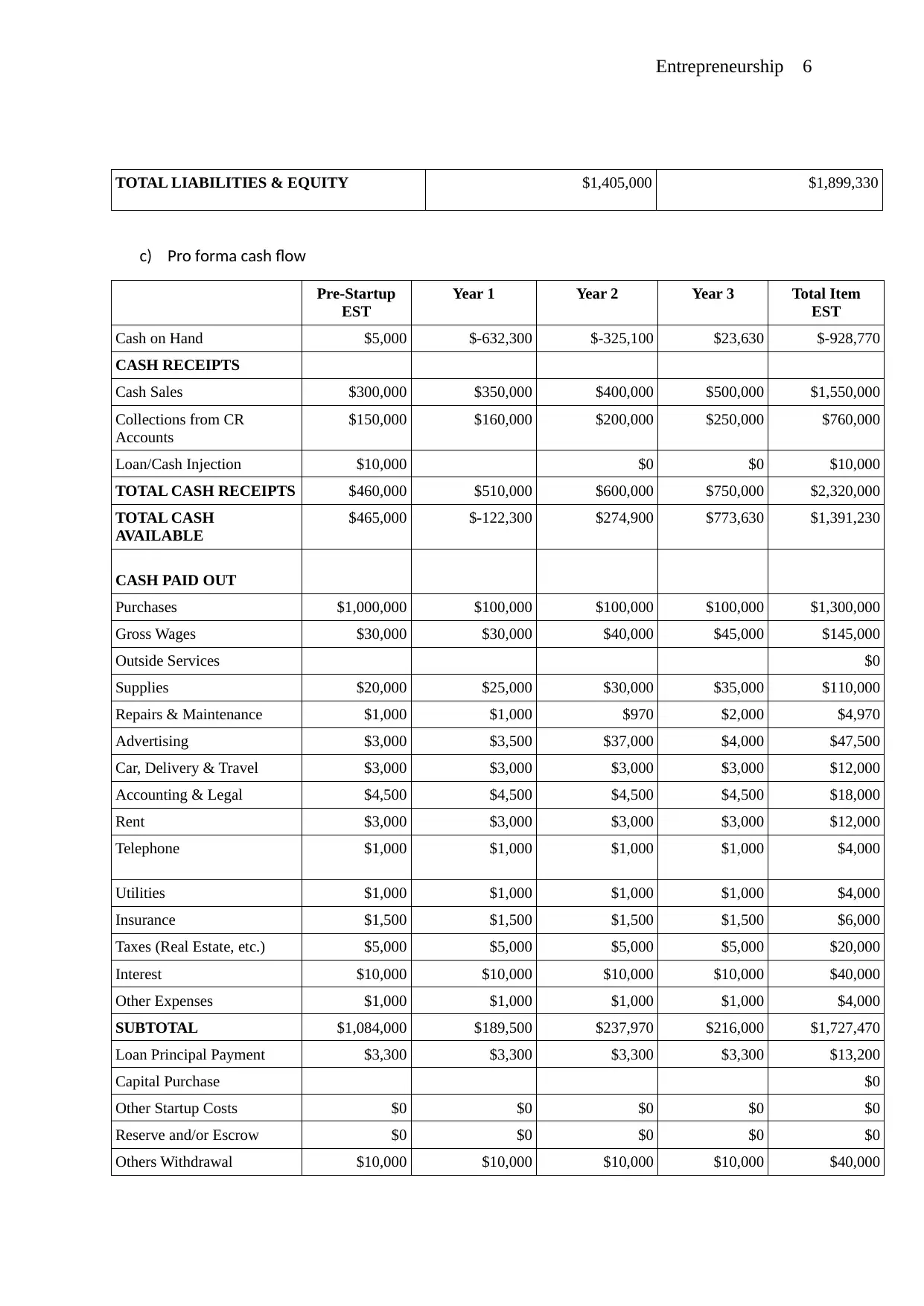
Entrepreneurship 6
TOTAL LIABILITIES & EQUITY $1,405,000 $1,899,330
c) Pro forma cash flow
Pre-Startup
EST
Year 1 Year 2 Year 3 Total Item
EST
Cash on Hand $5,000 $-632,300 $-325,100 $23,630 $-928,770
CASH RECEIPTS
Cash Sales $300,000 $350,000 $400,000 $500,000 $1,550,000
Collections from CR
Accounts
$150,000 $160,000 $200,000 $250,000 $760,000
Loan/Cash Injection $10,000 $0 $0 $10,000
TOTAL CASH RECEIPTS $460,000 $510,000 $600,000 $750,000 $2,320,000
TOTAL CASH
AVAILABLE
$465,000 $-122,300 $274,900 $773,630 $1,391,230
CASH PAID OUT
Purchases $1,000,000 $100,000 $100,000 $100,000 $1,300,000
Gross Wages $30,000 $30,000 $40,000 $45,000 $145,000
Outside Services $0
Supplies $20,000 $25,000 $30,000 $35,000 $110,000
Repairs & Maintenance $1,000 $1,000 $970 $2,000 $4,970
Advertising $3,000 $3,500 $37,000 $4,000 $47,500
Car, Delivery & Travel $3,000 $3,000 $3,000 $3,000 $12,000
Accounting & Legal $4,500 $4,500 $4,500 $4,500 $18,000
Rent $3,000 $3,000 $3,000 $3,000 $12,000
Telephone $1,000 $1,000 $1,000 $1,000 $4,000
Utilities $1,000 $1,000 $1,000 $1,000 $4,000
Insurance $1,500 $1,500 $1,500 $1,500 $6,000
Taxes (Real Estate, etc.) $5,000 $5,000 $5,000 $5,000 $20,000
Interest $10,000 $10,000 $10,000 $10,000 $40,000
Other Expenses $1,000 $1,000 $1,000 $1,000 $4,000
SUBTOTAL $1,084,000 $189,500 $237,970 $216,000 $1,727,470
Loan Principal Payment $3,300 $3,300 $3,300 $3,300 $13,200
Capital Purchase $0
Other Startup Costs $0 $0 $0 $0 $0
Reserve and/or Escrow $0 $0 $0 $0 $0
Others Withdrawal $10,000 $10,000 $10,000 $10,000 $40,000
TOTAL LIABILITIES & EQUITY $1,405,000 $1,899,330
c) Pro forma cash flow
Pre-Startup
EST
Year 1 Year 2 Year 3 Total Item
EST
Cash on Hand $5,000 $-632,300 $-325,100 $23,630 $-928,770
CASH RECEIPTS
Cash Sales $300,000 $350,000 $400,000 $500,000 $1,550,000
Collections from CR
Accounts
$150,000 $160,000 $200,000 $250,000 $760,000
Loan/Cash Injection $10,000 $0 $0 $10,000
TOTAL CASH RECEIPTS $460,000 $510,000 $600,000 $750,000 $2,320,000
TOTAL CASH
AVAILABLE
$465,000 $-122,300 $274,900 $773,630 $1,391,230
CASH PAID OUT
Purchases $1,000,000 $100,000 $100,000 $100,000 $1,300,000
Gross Wages $30,000 $30,000 $40,000 $45,000 $145,000
Outside Services $0
Supplies $20,000 $25,000 $30,000 $35,000 $110,000
Repairs & Maintenance $1,000 $1,000 $970 $2,000 $4,970
Advertising $3,000 $3,500 $37,000 $4,000 $47,500
Car, Delivery & Travel $3,000 $3,000 $3,000 $3,000 $12,000
Accounting & Legal $4,500 $4,500 $4,500 $4,500 $18,000
Rent $3,000 $3,000 $3,000 $3,000 $12,000
Telephone $1,000 $1,000 $1,000 $1,000 $4,000
Utilities $1,000 $1,000 $1,000 $1,000 $4,000
Insurance $1,500 $1,500 $1,500 $1,500 $6,000
Taxes (Real Estate, etc.) $5,000 $5,000 $5,000 $5,000 $20,000
Interest $10,000 $10,000 $10,000 $10,000 $40,000
Other Expenses $1,000 $1,000 $1,000 $1,000 $4,000
SUBTOTAL $1,084,000 $189,500 $237,970 $216,000 $1,727,470
Loan Principal Payment $3,300 $3,300 $3,300 $3,300 $13,200
Capital Purchase $0
Other Startup Costs $0 $0 $0 $0 $0
Reserve and/or Escrow $0 $0 $0 $0 $0
Others Withdrawal $10,000 $10,000 $10,000 $10,000 $40,000
⊘ This is a preview!⊘
Do you want full access?
Subscribe today to unlock all pages.

Trusted by 1+ million students worldwide
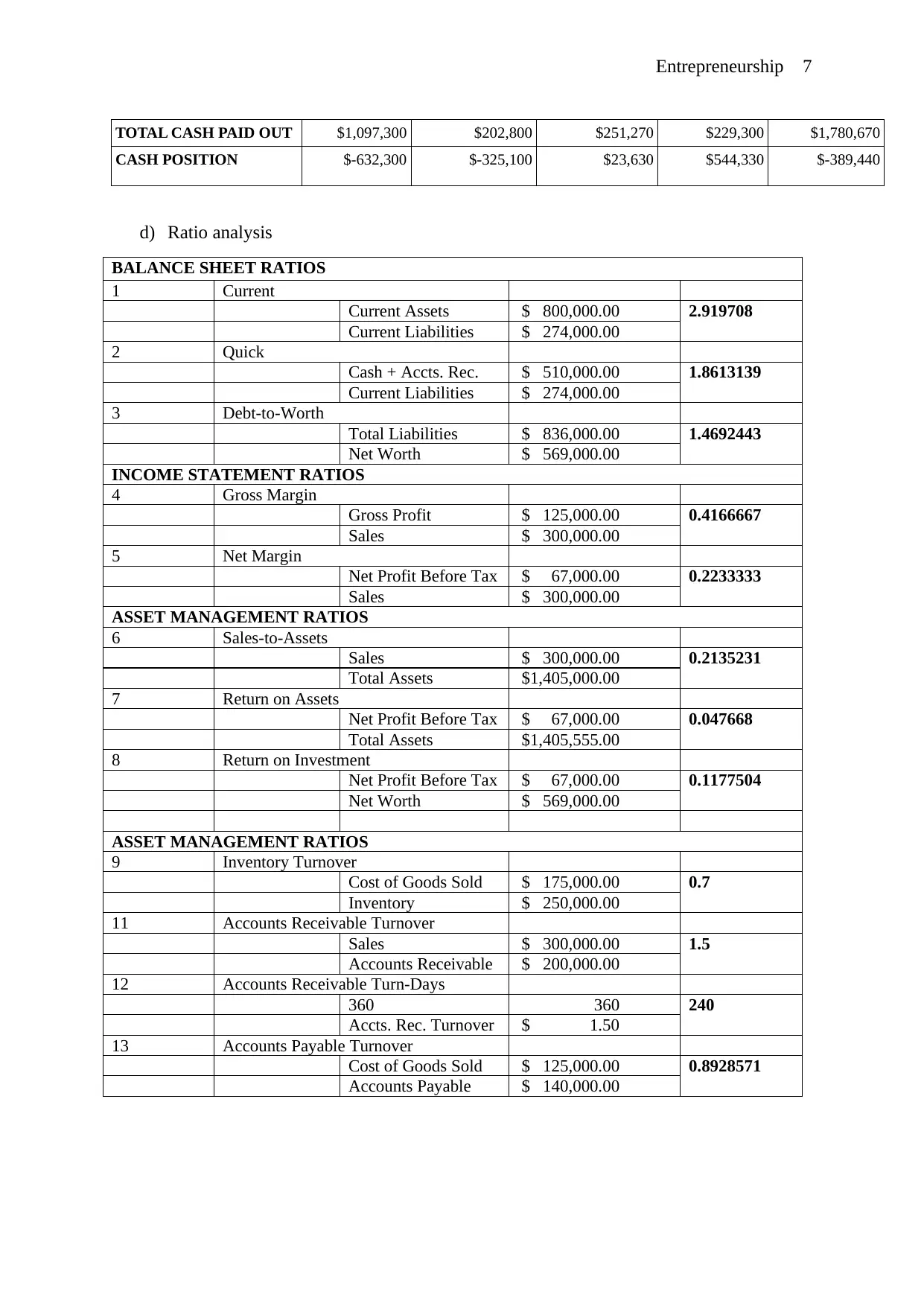
Entrepreneurship 7
TOTAL CASH PAID OUT $1,097,300 $202,800 $251,270 $229,300 $1,780,670
CASH POSITION $-632,300 $-325,100 $23,630 $544,330 $-389,440
d) Ratio analysis
BALANCE SHEET RATIOS
1 Current
Current Assets $ 800,000.00 2.919708
Current Liabilities $ 274,000.00
2 Quick
Cash + Accts. Rec. $ 510,000.00 1.8613139
Current Liabilities $ 274,000.00
3 Debt-to-Worth
Total Liabilities $ 836,000.00 1.4692443
Net Worth $ 569,000.00
INCOME STATEMENT RATIOS
4 Gross Margin
Gross Profit $ 125,000.00 0.4166667
Sales $ 300,000.00
5 Net Margin
Net Profit Before Tax $ 67,000.00 0.2233333
Sales $ 300,000.00
ASSET MANAGEMENT RATIOS
6 Sales-to-Assets
Sales $ 300,000.00 0.2135231
Total Assets $1,405,000.00
7 Return on Assets
Net Profit Before Tax $ 67,000.00 0.047668
Total Assets $1,405,555.00
8 Return on Investment
Net Profit Before Tax $ 67,000.00 0.1177504
Net Worth $ 569,000.00
ASSET MANAGEMENT RATIOS
9 Inventory Turnover
Cost of Goods Sold $ 175,000.00 0.7
Inventory $ 250,000.00
11 Accounts Receivable Turnover
Sales $ 300,000.00 1.5
Accounts Receivable $ 200,000.00
12 Accounts Receivable Turn-Days
360 360 240
Accts. Rec. Turnover $ 1.50
13 Accounts Payable Turnover
Cost of Goods Sold $ 125,000.00 0.8928571
Accounts Payable $ 140,000.00
TOTAL CASH PAID OUT $1,097,300 $202,800 $251,270 $229,300 $1,780,670
CASH POSITION $-632,300 $-325,100 $23,630 $544,330 $-389,440
d) Ratio analysis
BALANCE SHEET RATIOS
1 Current
Current Assets $ 800,000.00 2.919708
Current Liabilities $ 274,000.00
2 Quick
Cash + Accts. Rec. $ 510,000.00 1.8613139
Current Liabilities $ 274,000.00
3 Debt-to-Worth
Total Liabilities $ 836,000.00 1.4692443
Net Worth $ 569,000.00
INCOME STATEMENT RATIOS
4 Gross Margin
Gross Profit $ 125,000.00 0.4166667
Sales $ 300,000.00
5 Net Margin
Net Profit Before Tax $ 67,000.00 0.2233333
Sales $ 300,000.00
ASSET MANAGEMENT RATIOS
6 Sales-to-Assets
Sales $ 300,000.00 0.2135231
Total Assets $1,405,000.00
7 Return on Assets
Net Profit Before Tax $ 67,000.00 0.047668
Total Assets $1,405,555.00
8 Return on Investment
Net Profit Before Tax $ 67,000.00 0.1177504
Net Worth $ 569,000.00
ASSET MANAGEMENT RATIOS
9 Inventory Turnover
Cost of Goods Sold $ 175,000.00 0.7
Inventory $ 250,000.00
11 Accounts Receivable Turnover
Sales $ 300,000.00 1.5
Accounts Receivable $ 200,000.00
12 Accounts Receivable Turn-Days
360 360 240
Accts. Rec. Turnover $ 1.50
13 Accounts Payable Turnover
Cost of Goods Sold $ 125,000.00 0.8928571
Accounts Payable $ 140,000.00
Paraphrase This Document
Need a fresh take? Get an instant paraphrase of this document with our AI Paraphraser
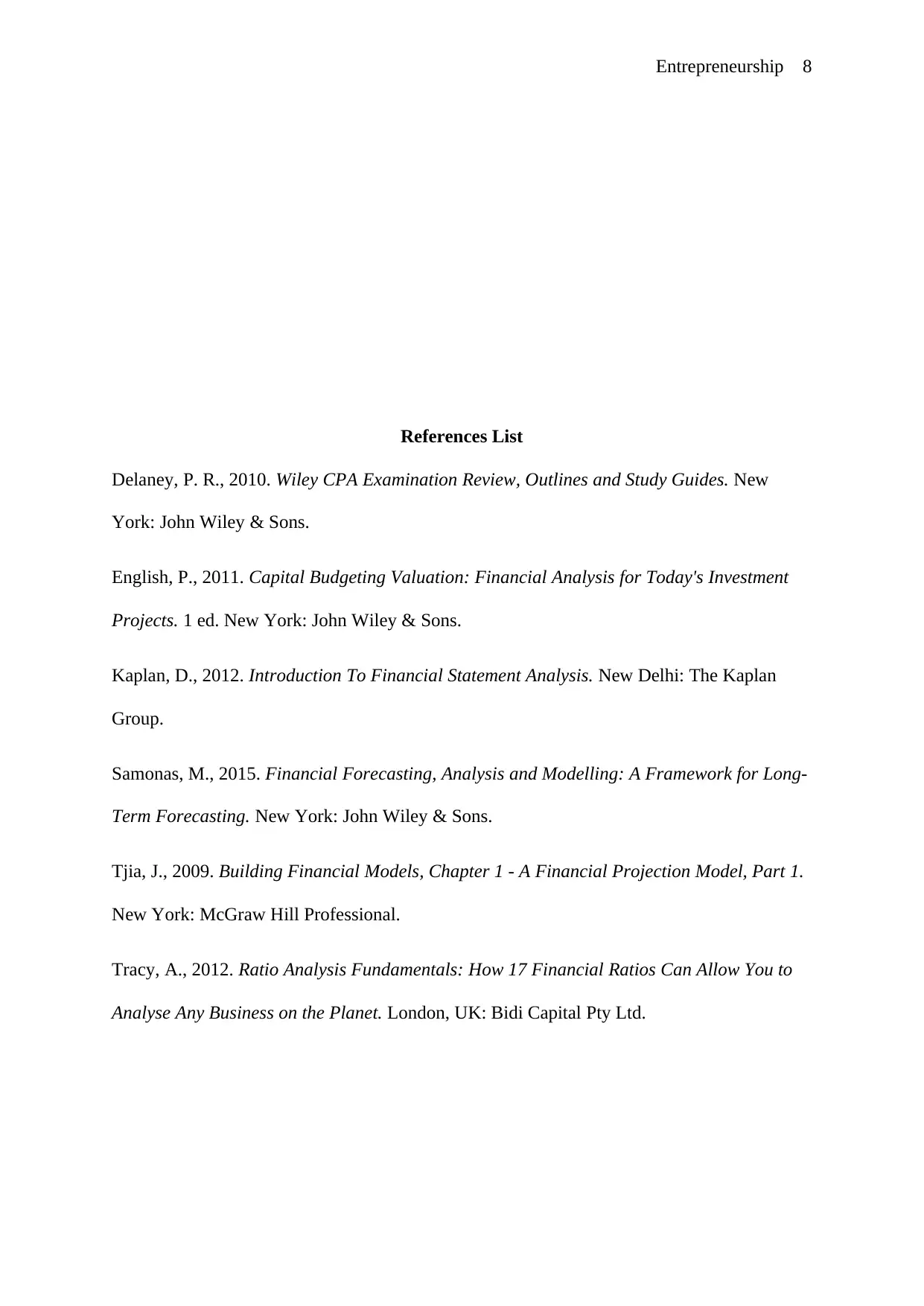
Entrepreneurship 8
References List
Delaney, P. R., 2010. Wiley CPA Examination Review, Outlines and Study Guides. New
York: John Wiley & Sons.
English, P., 2011. Capital Budgeting Valuation: Financial Analysis for Today's Investment
Projects. 1 ed. New York: John Wiley & Sons.
Kaplan, D., 2012. Introduction To Financial Statement Analysis. New Delhi: The Kaplan
Group.
Samonas, M., 2015. Financial Forecasting, Analysis and Modelling: A Framework for Long-
Term Forecasting. New York: John Wiley & Sons.
Tjia, J., 2009. Building Financial Models, Chapter 1 - A Financial Projection Model, Part 1.
New York: McGraw Hill Professional.
Tracy, A., 2012. Ratio Analysis Fundamentals: How 17 Financial Ratios Can Allow You to
Analyse Any Business on the Planet. London, UK: Bidi Capital Pty Ltd.
References List
Delaney, P. R., 2010. Wiley CPA Examination Review, Outlines and Study Guides. New
York: John Wiley & Sons.
English, P., 2011. Capital Budgeting Valuation: Financial Analysis for Today's Investment
Projects. 1 ed. New York: John Wiley & Sons.
Kaplan, D., 2012. Introduction To Financial Statement Analysis. New Delhi: The Kaplan
Group.
Samonas, M., 2015. Financial Forecasting, Analysis and Modelling: A Framework for Long-
Term Forecasting. New York: John Wiley & Sons.
Tjia, J., 2009. Building Financial Models, Chapter 1 - A Financial Projection Model, Part 1.
New York: McGraw Hill Professional.
Tracy, A., 2012. Ratio Analysis Fundamentals: How 17 Financial Ratios Can Allow You to
Analyse Any Business on the Planet. London, UK: Bidi Capital Pty Ltd.
1 out of 8
Related Documents
Your All-in-One AI-Powered Toolkit for Academic Success.
+13062052269
info@desklib.com
Available 24*7 on WhatsApp / Email
![[object Object]](/_next/static/media/star-bottom.7253800d.svg)
Unlock your academic potential
Copyright © 2020–2025 A2Z Services. All Rights Reserved. Developed and managed by ZUCOL.





